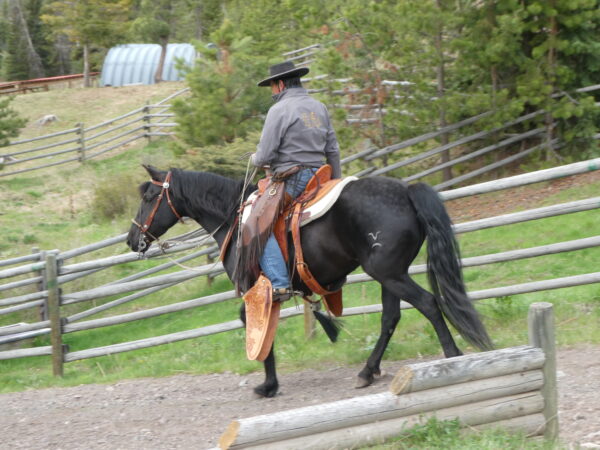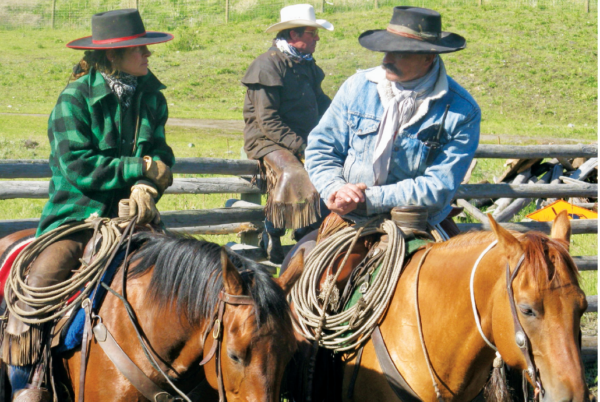Canadiana Vaquero
By Terri Mason

Miles Kingdon is a cowboy’s cowboy, a man well-respected in the ranching world for his seemingly magical abilities with cattle and horses. Whether riding a workshop rider’s young mare or a seasoned bridle horse, you understand the phrase “at one with his horse”—it’s a dynamic, controlled, compassionate partnership.
But as sophisticated as he is in the saddle, it wasn’t until recently that he learned what a podcast was when he was asked to be a guest on Jason Swick’s show, Let Freedom Rein. In fairness, there’s not a lot of reception deep in the arid, semi-desert of southern British Columbia, where Miles and his long-standing partner Kathryn (Possum) Normand have their new outfit, Orange Valley Ranch. But there is good grass and plenty of soul-filling work in building their hard-earned, forever homeplace.
Miles hails from deep in southeastern Saskatchewan, where the towns in North Dakota across the Medicine Line were closer than any in Canada. His parent’s outfit shared a fence line with Coalfields, a 33,000-acre community pasture, of which all but 100 acres was native grass.
“I used to ride colts for people, starting when I was 13; I rode quite a few on the prairies,” said Miles. “I grew up on miles and miles of waving prairie wool.”
His was a childhood that won’t be seen again. “My brother and I rode a lot,” he said. “We had tractors, but in the wintertime, Dad would drain the radiators, and we’d use teams for chores and to go to the neighbours, and sometimes we’d get snowed in.”
Not surprisingly, Miles’ first job was riding community pasture. Next came the sprawling (now 1.2 million acres) Douglas Lake Cattle Company in B.C.
Back then, several hands who cowboyed on Douglas Lake had over 30 years of experience; a few had 40-plus years, and many had at least 15 years.

Miles roping in the North Courtney branding trap on Shorty. Quilchena Cattle Company, 2007
“It was a huge benefit to the ranch and the young people coming up and riding out behind them stiffnecked ol’ boogers,” he said. “I say stiffnecked because when they hit a high trot and rode out, they rode for seven or eight miles before they’d get to the cows, do a day’s work of sorting and trailing cattle, and then jog the eight miles back home again. So it was a long day. And when they were riding out in the morning, they didn’t bother looking back,” he said.
“The other thing I noticed was there were a lot of native cowboys, and their fathers had been cowboys, and their grandfathers had been cowboys,” he said. “Heck, their moms might have been cooks, but they got along with a horse better than most cowboys did. And they could read cattle so well. It was a knowledge born into them from generations of working with livestock.”
These and other superb, experienced horsemen strongly influenced Miles. “Cowboys like Spook McCray, Jake Coutlee, and Ken Knapp—a very good, well-rounded cowboy.”
Soon Miles’ skill was becoming apparent. “I got to where my horses would work pretty good,” he said modestly. “I was happy to be on a horse, but I knew they could get a little better because, and this is an important factor, when I went to Douglas Lake, there were a lot of guys using the bosal, and they used it differently to what I’d seen,” he said.

Possum, her brother, John Normand and Miles; Burgoine Corrals, Quilchena Cattle Company, June 2008
The use of the bosal came with the early Californios who brought up the herds for the Gold Rush, and these techniques were passed down.
“The fellas who owned the early herds kept the cowboys working for them. So, that style of going from the bosal to the bridle, I saw older guys using it at that time,” he said.
“Some guys on Douglas Lake were really smooth with their horses. Dan Murphy was smooth; he didn’t use a spade bit. Paul Jex Blake did; John Young was good with a bosal; Orville was good with a bosal, and Ken Knapp as well,” he said.
Four hard-riding years later, Mark Grafton offered Miles the job of cowboss at the Bar K, north of Prince George, B.C. He then rode the Nicola Ranch and was named the cowboss of the Empire Valley Ranch. He was on his way.
Miles also got busy building a marriage and a family. Then, in the fall of 1992, disaster struck. While his wife, Tonya, and their daughter, Shannon, enjoyed a day together, Miles and his three sons, Riley, 2, Adam, 7 and Jessie, 9, had a “guy’s day.” On the way home after tearing out a cow camp, his truck’s front wheel got sucked into the soft mud and suddenly plunged over the steep cliff, high over Carpenter Lake near Lillooet. As the Dodge rapidly sank, the windshield blew out. Miles, who wasn’t wearing a seatbelt, dove over and over, desperately trying to save his sons. The truck was later found by divers to be some 100 feet below the surface of the black water. Divers repeatedly searched and then began dragging the lake. It was months before their son’s bodies were found and they could be laid to rest in Merritt. In the wake of the tragedy and despite the birth of another precious daughter, Emily, the young couple’s marriage eventually crumbled.
Miles ultimately headed to the Quilchena.
It was on this spread that he became re-acquainted with Kathryn (Possum) Normand. The Louisiana cowgirl was a fine hand, and the now-couple rode for the Quilchena for 15 years. Then, on December 31, 2013, the ranch was sold.
The upheaval was huge—no ranch, no jobs, no home. “Possum had broken her leg real bad, so we moved here to Orange Valley Ranch outside of Merritt to caretake,” Miles explained. It turned out to be the perfect place for the couple to heal and make some plans. They bought the place in the fall of 2020.
Now, it was time to put their plans into action. Miles’ rep as a horseman far exceeded the borders of the Canadian province, and with prodding from friends and support from Possum, Miles entered into the world of horsemanship clinics.
said. “What I teach is horsemanship, what I call the signal, balanced ride. The bosal is probably the best tool known to man that teaches the horse that you have no control.”
WAIT. WHAT?
“And that’s a good thing,” he continued. “Because people need to learn to stop controlling. You cannot control an animal that needs to make choices for itself.”
Miles is also the judge of a major show in California. Several years ago, Bruce Sandifer, the president of the Californio Bridlehorse Association, asked him to judge a competition called Early Californios Skills of the Rancho. “It’s ranch horse patterns, ranch roping, sorting livestock. So it’s really a ranch rodeo, but they have to work them as if we were working on the outfit. If we start jamming cattle around rattling the panels, the Boss is gonna kick us out of the corral,” he laughs.
His workshops are well-attended, and ninety-nine percent are women. Along with signal balanced riding, Miles teaches ranch roping, stockmanship, how to read stock, how to read horses, and how to be with a horse. “People spend a lot of money on clinics, and they don’t have the basics of how to read a horse,” he said. “People look away from the horse’s head way too much.”
“The bosal is the best tool known to man that teaches the horse that you have no control.”
Since the pandemic, the couple has been busier than ever. “I don’t know how many workshops I do,” Miles said. “In winter, I do private lessons every second weekend all winter. I’m on the road every weekend from mid-May to mid-September, and then we do private or semi-private workshops at our outfit here.”

Miles paused. “I never thought it could be a business,” he said. “But I knew I needed to do something with horses because that’s what I knew. Possum just started looking after the bookings and the office—and I just started teaching.”
Miles has ridden a wide circle, and with his life story of highs and lows, both he and Possum have achieved that which eludes many people—contentment.
“When we realized why we were here, all we could say was thank you, giving thanks to God for us being here,” he said. “It just seemed to play out the way we hoped.”















